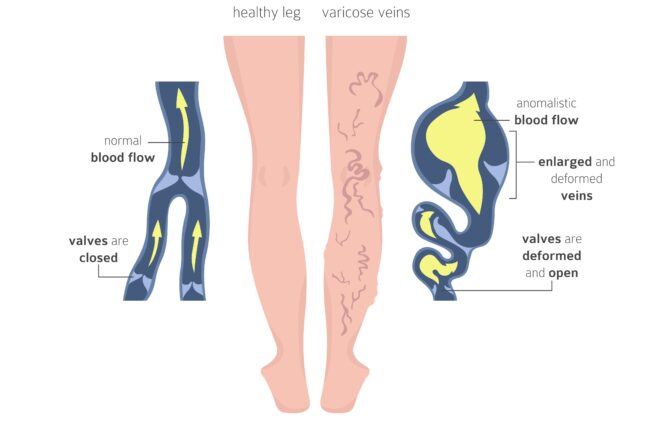Standing desks have become pretty popular in recent years. And with health claims like improved spine health, lower chances of developing heart disease, and improved energy levels, that’s not surprising. But are standing desks really good for you? And how do they affect vein health in particular?
Read on to find out.
The benefits
Now, standing desks do have a few benefits. In recent studies, researchers found that standing desks helped participants:
- Reduce back pain. When you stand, you engage your core and leg muscles, thus reducing the strain on your spine. Additionally, many find it easier to maintain good posture when standing, reducing stress on vertebrae and spinal disks.
- Burn more calories. If you stand for half your workday (~4 hours), you’ll burn around 32 additional calories.
- Improve mood and heighten energy levels. As we mentioned, standing desks activate more of your muscles and can reduce back pain levels. And on top of that, they prompt more general movement from your body than sitting does.
The risks
That said, standing desks have their own risks, and here’s where we get into vein health. Studies found that standing for multiple hours a day, several days a week is actually worse on the leg veins than sitting and can increase the chances of developing venous disorders.
That’s because when you stand, your leg veins strain against a constant gravitational pull. Additionally, they don’t get much help from surrounding leg muscles; while standing does activate them more than sitting, it doesn’t do so in a way that helps them act as supportive pumps for your veins. And on top of that, keeping your leg muscles locked in the same position for hours on end can lead to muscle fatigue and tension, which makes matters worse. Hence, your leg veins will have a harder time pulling blood from your feet to your heart. And the increased strain can lead to reflux, a condition where the blood starts pooling in the veins.
Reflux can lead to all sorts of unpleasantness. In the short term, you might see your lower legs occasionally swell, feel very tired at the end of the day, or even start hurting due to the excess fluid overwhelming the capillaries and flowing into the surrounding tissue. And in the long term, it can lead to varicose veins.

illustrated infographic of two legs. One is healthy with good circulation, the other has bad circulation and varicose veins.
Our tips
However, standing desks aren’t the devil, and sitting is still not fantastic for your veins. So, here’s our advice:
- Get a stand-sit desk instead of a static standing one and break up your standing and sitting time into smaller chunks instead of hours-long stretches. For example, sit for half an hour, then adjust your desk to stand for the next half hour.
- Try to squeeze in some movement. You could do something as simple as shifting your weight from foot to foot while standing or rotating your ankles when sitting.
- Wander around a little more, if you can.
- Go for a little walk during your lunch break to boost your circulation
- Get a pair of compression socks to support the circulation in your legs
- Go to the gym or an exercise class after work
What about a standing treadmill desk?
Movement is great for veins and overall health. But treadmill desks aren’t a fantastic solution. While walking while you work will definitely make your leg veins happy, it can take a toll on your concentration. One study found that participants using a sitting desk could recall lists of words and work out mental math problems better than their treadmill desk counterparts. Additionally, those using a treadmill desk typed slower and made more errors.
Not to mention, there is a thing as too much walking. Using a treadmill desk for several hours in a row daily can start taking a toll on your leg joints and even your leg muscles.
So, to sum up
As with most things in life, a balanced approach is best. With a 50-50 split between sitting and standing and adding more movement to your day, you’ll get the benefits of a standing desk without the risks to your vein health.
That said, standing (and staying static too long in general) aren’t the only varicose vein risk factors. So, if you start to experience symptoms like burning, itching, fatigue, or achiness around your legs, seek specialist advice.
Book your consultation by calling 0420 102 637 or filling out this form. We’ll be happy to answer any of your questions, check on your veins, and recommend the next steps.
See more vein facts: Answering Your Vein FAQs
